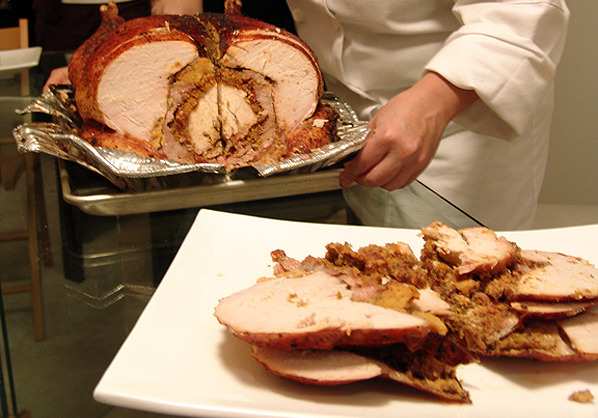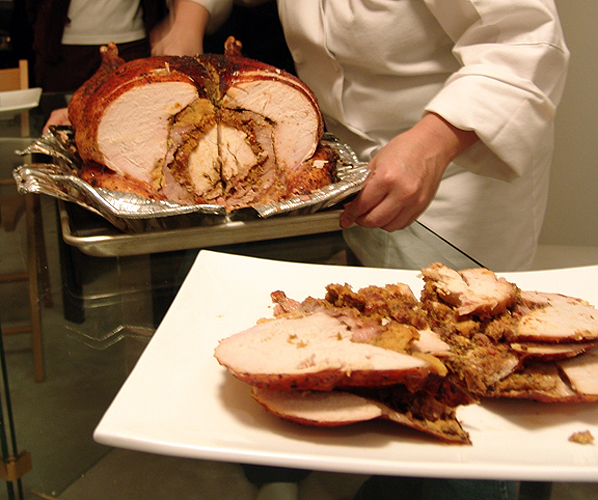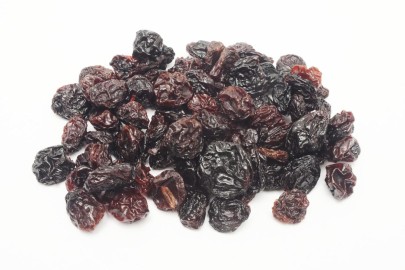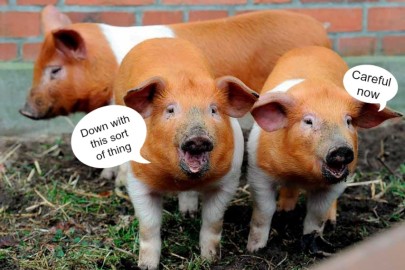Christmas is coming, so carve yourself a dainty slice of Turducken (but go easy on the Ortolan Bunting), this week’s weird Wikipedia article unearthed by the Wikiworm…
Turducken is a dish consisting of a deboned chicken stuffed into a deboned duck, which is in turn stuffed into a deboned turkey. The word. turducken is a portmanteau of turkey, duck, and chicken. The dish is a form of engastration, which is a recipe method in which one animal is stuffed inside the gastric passage of another.
The thoracic cavity of the chicken/game hen and the rest of the gaps are stuffed, sometimes with a highly seasoned breadcrumb mixture or sausage meat, although some versions have a different stuffing for each bird. The result is a fairly solid layered poultry dish, suitable for cooking by braising, roasting, grilling, or barbecuing.
In the United Kingdom, a turducken is a type of ballotine called a “three-bird roast” or a “royal roast”. The Pure Meat Company offered a five-bird roast (a goose, a turkey, a chicken, a pheasant, and a pigeon, stuffed with sausage), described as a modern revival of the traditional Yorkshire Christmas pie, in 1989; and a three-bird roast (a duck stuffed with chicken stuffed with a pigeon, with sage and apple stuffing) in 1990. Multi-bird roasts are widely available.
In his 1807 Almanach des Gourmands, gastronomist Grimod de La Reynière presents his rôti sans pareil (“roast without equal”)—a bustard stuffed with a turkey, a goose, a pheasant, a chicken, a duck, a guinea fowl, a teal, a woodcock, a partridge, a plover, a lapwing, a quail, a thrush, a lark, an ortolan bunting and a garden warbler—although he states that, since similar roasts were produced by ancient Romans, the rôti sans pareil was not entirely novel. The final bird is very small but large enough to just hold an olive; it also suggests that, unlike modern multi-bird roasts, there was no stuffing or other packing placed in between the birds.
Another version of the dish is credited to French diplomat and gourmand Charles Maurice de Talleyrand-Périgord. The 1891 newspaper article French Legends Of The Table offers Quail a la Talleyrand:
The following for instance, is Talleyrand’s fanciful and somewhat roundabout way of roasting a quail. On a day of “inspiration gourmande” at his hotel in the Rue Saint-Florentin, he composed the following recipe: Take a plump quail, seasoned with truffles, and made tender by having been put into champagne. You put it carefully inside a young Bresse chicken; then sew up the opening, and put dabs of butter all over the chicken. Again, you put the chicken inside a fine Berri turkey, and roast the turkey very carefully before a bright fire. What will be the result? All the juice of the turkey is absorbed by the fowl, and all the juice of the fowl in its turn by the quail. After two hours roasting the fowl, which in reality it composed of three fowls, is ready, and you place the steaming trinity upon a dish of fine porcelain or chiseled silver. Then you pull the chicken out of the turkey, and the quail out of the chicken. The quail? Is it correct to talk of the quail, when this delicious, perfumed dish is indeed too good for any name? You take the quail as you would some sacred relic, and serve it hot, steaming, with its aroma of truffles, after having roasted it to a golden yellow by basting it diligently with the best Gournay butter.
The book Passion India: The Story of the Spanish Princess of Kapurthula features a section that recounts a similar dish in India in the late 1800s:
“Invited by Maharajah Ganga Singh to the most extraordinary of dinners, in the palace at Bikaner, when Anita asks her host for the recipe of such a succulent dish, he answers her seriously, “Prepare a whole camel, skinned and cleaned, put a goat inside it, and inside the goat a turkey and inside the turkey a chicken. Stuff the chicken with a grouse and inside that put a quail and finally inside that a sparrow. Then season it all well, place the camel in a hole in the ground and roast it.”
Gooducken is a goose stuffed with a duck, which is in turn stuffed with a chicken.













Much as I love to eat meat, I find these contrivances somehow revolting. They seem an affront to the dignity of the animal (like KFC’s ‘chicken popcorn’).
Never heard of ‘chicken popcorn’ – until today, but then it is some years since I’ve had children young enough to road-test it. And surely any ‘dignity’ the animal may have once possessed has long ago been stripped away by soaking in its own faecal soup, ingesting carcinogens, and being pumped-up by chlorine and other toxic chemicals. Bad enough to be born into an ebola infected village in Liberia, but imagine being born as a genetically engineered chicken on one of those ‘concentration camp’ farms?
I often see ‘three bird roasts’ in the freezer cabinets at Aldi and Lidl…strangely I have managed to resist buying one…there’s something a bit decadent about them